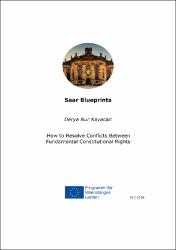| dc.contributor.author | Kayacan, Derya Nur | |
| dc.date.accessioned | 2024-03-26T09:15:33Z | |
| dc.date.available | 2024-03-26T09:15:33Z | |
| dc.date.issued | 2016 | en_US |
| dc.identifier.citation | Nur Kayacan, Derya (2016). How to resolve conflicts between fundamental constitutional rights. Saar Blueprints, 2, 1-28. | en_US |
| dc.identifier.issn | 2199-0050 | |
| dc.identifier.uri | https://hdl.handle.net/20.500.12846/922 | |
| dc.description.abstract | Overtime, especially after the Second World War, fundamental rights have gained more
importance than ever. The legislatures have broadened the list, by adopting and legally
protecting a wider range of fundamental rights. But more importantly, the ample interpretation
of the legislation by the Courts made a much more generous contribution in establishing an
immense catalogue.1
For example the United States Supreme Court has added rights through its interpretation,
which were not explicitly enlisted in the Bill of Rights, such as the right to vote,2
the right to
privacy3
and the right to an abortion. 4
Fundamental rights were initially adopted into the legislation to protect the individuals from
the state and its powers.5
“They are designed to protect the individual from unwarranted
interference in crucial aspects of her life.”6 But in time the aspect of fundamental rights have
changed. Apart from the duty to respect fundamental rights of individuals, the State also
carries the obligation, namely the positive obligation, to protect them from each other. “This
positive obligation to provide protection presupposes the adoption of legislative,
administrative, judicial and substantive measures to protect individuals against violation of
their fundamental rights by other individuals. It leads necessarily to an increase in the
number of actions founded on the violation of individual freedoms and as a result, to an
escalation in the number of conflicts between fundamental rights.”7 The State is not only
obliged to respect the fundamental rights of the individuals, but also has to protect their rights
from being violated by other individuals as well. | en_US |
| dc.language.iso | eng | en_US |
| dc.publisher | Saar Blueprints | en_US |
| dc.rights | info:eu-repo/semantics/openAccess | en_US |
| dc.title | How to resolve conflicts between fundamental constitutional rights | en_US |
| dc.type | article | en_US |
| dc.relation.journal | Saar Blueprints | en_US |
| dc.identifier.issue | 2 | en_US |
| dc.relation.publicationcategory | Makale - Uluslararası Hakemli Dergi - Kurum Öğretim Elemanı | en_US |
| dc.contributor.department | TAÜ, Hukuk Fakültesi, Kamu Hukuku Bölümü | en_US |
| dc.identifier.startpage | 1 | en_US |
| dc.identifier.endpage | 28 | en_US |

















